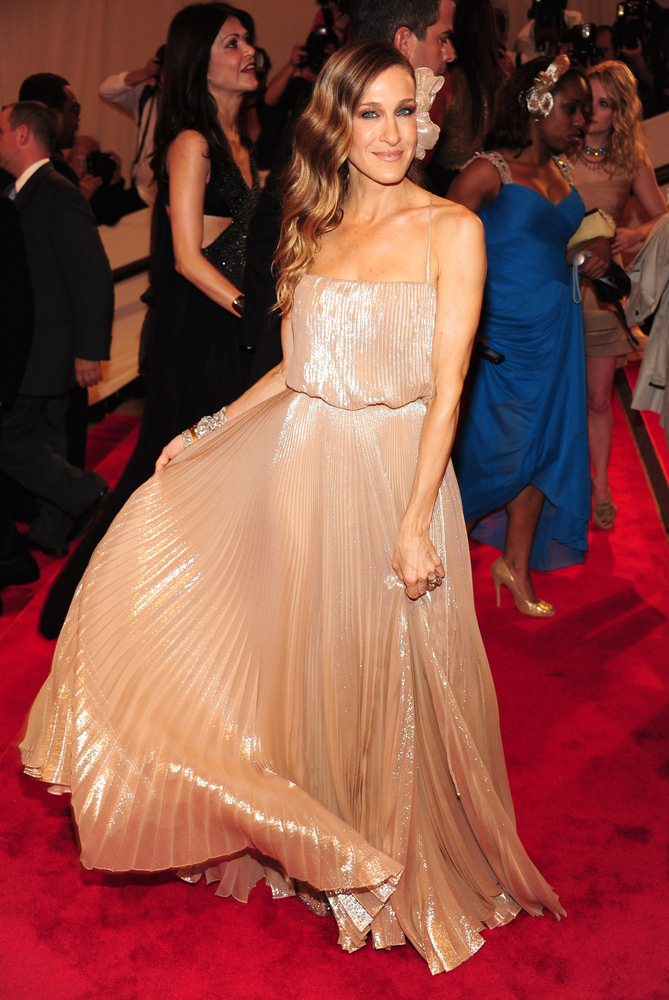Think Halston and do images of True Fashionista glitterati dancing the night away at Studio 54 fill your mind? Perhaps it’s images the many photos of stars of the day all hanging with the man himself, sporting his trademark sunglasses. Halston dressed and impressed them all for many years, and in the flashy 1970’s scene, his name was synonymous with both high fashion and high society.
Born in Des Moines, Iowa on April 23, 1932, Roy Halston Frowick was the son of a Norwegian-American accountant and his wife. Even as a young boy, he loved to alter and make clothes for his mother and sister, where he developed a special fondness for designing hats. He studied at Indiana University for one semester before his family moved to Chicago in 1952. Halston then took a night course at the Art Institute of Chicago while working as a fashion merchandiser at the upscale department store Carson Pirie Scott. While here, his big break came in the form of a story in the Chicago Daily News about his unique colorful hats decorated with jewels, fringes and flowers. He took this moment to shorten his name to simply Halston, establishing his own milliner business in 1953.
Halston’s sensational creations earned him a loyal clientele of regular customers including Kim Novak, Gloria Swanson, Deborah Kerr and Hedda Hopper. Following a move to NYC to work for the famed French milliner Lilly Daché, Halston’s talent and dedication earned him the Daché co-designer title after only one year. Not long afterward, he accepted the head milliner position at the famed Bergdorf Goodman. After two years at Bergdorf, Halston became the store’s first designer to have his name placed in the hats he created.
A crowning moment came in 1961 when Jackie Kennedy wore the famous pill box hat that he designed for the Presidential Inaugural, and the Halston name became instantly synonymous with high fashion and high society. Halston’s True Fashionista friends and clients soon included some of the most glamorous and beautiful women in the world like Rita Hayworth, Liza Minnelli, Marlene Dietrich and Diana Vreeland. Into the 70’s, the bunch including Halston and comrade Andy Warhol were oft-spotted hanging at the legendary Studio 54 if not Warhol’s Factory. Halston was also involved in an on-again off-again romance with Venezuelan-born artist Victor Hugo, whom he met in 1972. It was a relationship that lasted 10 years.
In 1966, after hats fell out of fashion, Halston expanded his work to womenswear. His designs, renowned for their sexy yet elegant style, were met with immense acclaim. Halston launched his first ready-to-wear line, Halston Limited, in 1969. His look was simple, minimalist yet sophisticated, glamorous and comfortable at the same time. In 1972, he introduced a simple shirtwaist dress made from Ultrasuede, a microfiber fabric invented in 1970 that was durable, washable, and gorgeous. Two years later, he offered the world his most iconic design, the halter dress. It was an instant hit in America’s burgeoning discotheque scene, giving women the narrow, elongated silhouette they craved. He also successfully re-introduced pants for women, famously saying, “Pants give women the freedom to move around they’ve never had before. They don’t have to worry about getting into low furniture or low sportscars. Pants will be with us for many years to come—probably forever if you can make that statement in fashion.”
Throughout the 70’s, his line expanded to include menswear, luggage, handbags, lingerie and bedding. By now Halston’s True Fashionista boutique drew an even bigger circle of celebrity clients like Lauren Bacall, Margaux Hemingway and Elizabeth Taylor and Anjelica Huston. In 1975 a deal with cosmetics giant Max Factor introduced the world to his namesake fragrances for men and women. Two years later, sales from the perfume alone garnered $85 million. The name Halston at this point epitomized everything that was of this era.
Halston was commissioned in 1977 to create uniforms for Braniff Airways flight attendants, which the airline promptly extended to seat covers and plane colors as well, dubbing the whole campaign “Ultra Touch” in reference to his famous Ultrasuede designs. Further corporate commissions followed, including the Pan American Games and U.S. Olympic Team’s uniforms in 1976, as well as the Girl Scouts, NYPD and Avis Rent A Car.
By the 1980’s, alas, it was clear that the times were changing. Halston signed a six-year licensing deal with J.C. Penney to bring an affordable line of clothing, accessories, cosmetics and perfumes to a wider audience. The move failed, as high-end fashion retailers felt that his name had been “cheapened”. Following buyouts and failed relaunches by several companies over the years, the Halston line was quietly relaunched in 2013 as the Halston Heritage collection, an approachable luxury lifestyle brand now available at luxury retailers around the world.
Halston himself was by the late eighties dealing with more personal issues, testing positive for HIV in 1988. As his health deteriorated, he moved to San Francisco to be with family and succumbed to Kaposi’s sarcoma, an AIDS-related illness, on March 26, 1990.
Halston has been commemorated for his work and influence a number of times since, including a 1991 biography by Steven Gaines, Simply Halston: The Untold Story. The TV series based on his book starring Ewen McGregor (who is also producing) is currently in production. A documentary will also hit theaters in May 2020. Halston has indeed left a True Fashionista legacy that we won’t (and don’t want to) forget.
Sources:
Image: Everett Collection / Shutterstock.com
The post HISTORY OF HALSTON appeared first on True Fashionistas.





























